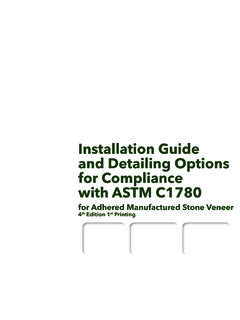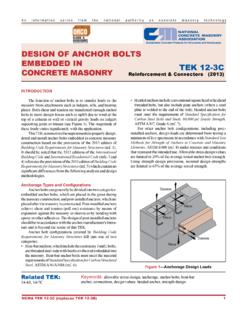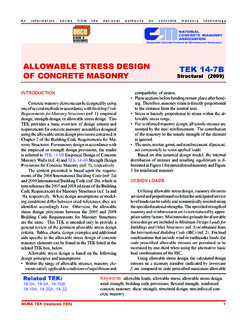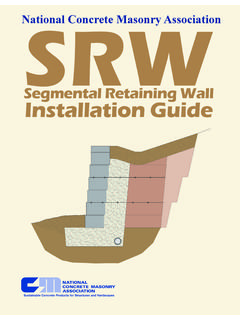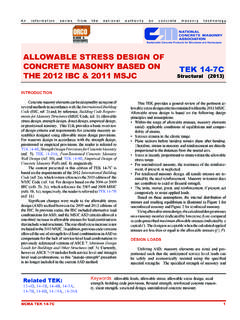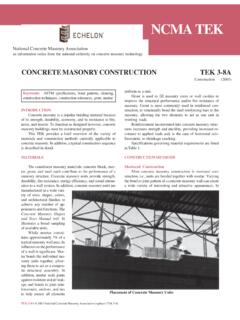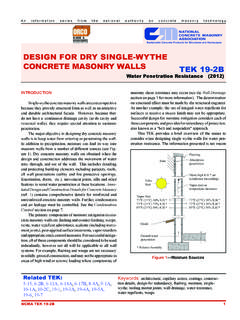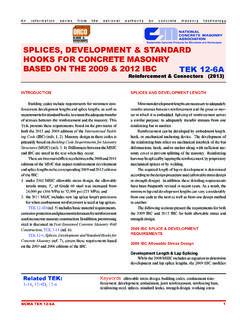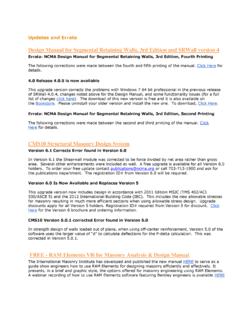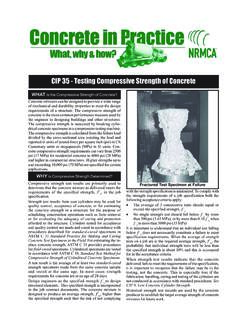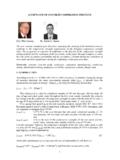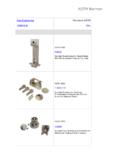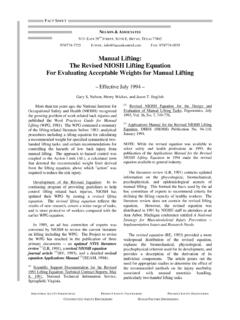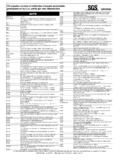Transcription of EVALUATING THE COMPRESSIVE STRENGTH OF ... - ncma …
1 An information series from the national authority on concrete masonry technology EVALUATING THE COMPRESSIVE . STRENGTH OF CONCRETE MASONRY. TEK 18-1C. Quality Assurance & Testing (2014). INTRODUCTION UNIT STRENGTH METHOD. Structural performance of concrete masonry is largely The unit STRENGTH method is often considered the least dependent upon three key criteria: expensive and most convenient of the two methods. However, the engineering rationale forming the basis of the structure's the unit STRENGTH method also tends to yield more conservative design; masonry strengths when compared to the prism test method. the physical characteristics of the materials used in the Compliance with f'm by the unit STRENGTH method is based construction ( , the masonry units, grout, mortar, and on the net area COMPRESSIVE STRENGTH of the units and the type reinforcement); and of mortar used. The COMPRESSIVE STRENGTH of the concrete ma- the quality of the construction used in assembling these sonry assemblage is then established in accordance with Table components.
2 1. Table 1 is based on criteria from Specification for Masonry The first step in the design of any engineered masonry Structures (ref. 2). structure is determining anticipated service loads. Once these Use of the unit STRENGTH method requires the following: loads are established, the required STRENGTH of the masonry Concrete masonry units must be sampled and tested in can be determined. The designation f'm, indicates the speci- accordance with ASTM C140, Standard Test Method for fied COMPRESSIVE STRENGTH of masonry. It is used throughout the design and, in accordance with the appropriate code, to Table 1 COMPRESSIVE STRENGTH of Masonry Based predict the STRENGTH and behavior of the masonry assembly on the COMPRESSIVE STRENGTH of and thus to size masonry elements. It should be stressed that Concrete Masonry Units and Type of Mortar Used the specified COMPRESSIVE STRENGTH of the masonry is related in Construction (ref. 2). to but not always equal to the tested COMPRESSIVE STRENGTH of Net area Net area COMPRESSIVE STRENGTH the masonry.
3 COMPRESSIVE STRENGTH of concrete masonry units, psi To ensure that a safe and functional structure is being of masonryA, (MPa). constructed that will meet or exceed the intended service life, psi (MPa) Type M or S Type N mortar measures must be taken to verify that the COMPRESSIVE STRENGTH mortar of the assembled materials (including masonry units, mortar 1,700 ( ) ---- 1,900 ( ). and grout if used) meet or exceed the specified COMPRESSIVE 1,900 ( ) 1,900 ( ) 2,350 ( ). STRENGTH of the masonry. 2,000 ( ) 2,000 ( ) 2,650 ( ). Compliance with the specified COMPRESSIVE STRENGTH is 2,250 ( ) 2,600 ( ) 3,400 ( ). verified by one of three methods: the unit STRENGTH method, 2,500 ( ) 3,250 ( ) 4,350 ( ). the prism test method, or by removing units from existing construction. These methods are referenced in masonry design 2,750 ( ) 3,900 ( ) ---- codes (refs. 1, 4), specifications (ref. 2), and standards (ref. 3,000 ( ) 4,500 ( ) ---- 3) as rational procedures for verifying masonry COMPRESSIVE A.
4 For units less than 4 in. (102 mm) nominal height, use STRENGTH . 85% of the values listed. Related TEK: Keywords:ASTM standards, COMPRESSIVE STRENGTH , prisms from existing 1-1F, 18-9A construction, prism testing, specified COMPRESSIVE STRENGTH of masonry (f'm). testing, unit STRENGTH method NCMA TEK 18-1C (replaces TEK 18-1B) 1. Sampling and Testing Concrete Masonry Units and Related mm) in nominal height. Units (ref. 5) and meet the requirements of ASTM C90, When higher STRENGTH masonry materials are specified, it Standard Specification for Loadbearing Concrete Masonry may be more cost effective to utilize the prism test method to Units (ref. 6). (Note that ASTM C140 allows the test of demonstrate compliance with f'm due to the level of conservatism one set of units to be applied to any number of concrete inherent in the unit STRENGTH method; , the costs of prism masonry units or related units of any configuration or testing may be offset by the construction savings resulting dimension manufactured by the producer using the same from a more economical design that takes advantage of using materials, concrete mix design, manufacturing process, a higher COMPRESSIVE STRENGTH for the same specified materials.
5 And curing method.) Note that the unit STRENGTH values in the 2013 Specifica- Mortar bed joints used in construction must not exceed tion for Masonry Structures ( , those in Table 1) are less 5. /8 in. thickness ( mm). conservative than values in previous editions. The historical If grouted masonry is used in construction, the grout must conservatism was due to two primary reasons: meet either the proportion or the property specification 1) The original database of tested COMPRESSIVE strengths was of ASTM C476, Standard Specification for Grout for based on the testing procedures and equipment that were Masonry (ref. 7), and the 28-day COMPRESSIVE STRENGTH considerably less refined than they are today. Current ASTM. of the grout must equal or exceed f'm but not be less than C1314, Standard Test Method for COMPRESSIVE STRENGTH of 2,000 psi (14 MPa). When property specifications are Masonry Prisms (ref. 3), requirements produce more con- used, the COMPRESSIVE STRENGTH of the grout is determined sistent and repeatable COMPRESSIVE strengths, particularly in accordance with ASTM C1019, Standard Test Method the requirements for more stable bearing platens on the for Sampling and Testing Grout (ref.
6 8). compression testing equipment. Mortar must comply with requirements of ASTM C270, 2) Historical testing procedures did not strictly control the Standard Specification for Mortar for Unit Masonry construction, curing, and testing of the masonry prisms. (ref. 9). As a result, a single set of materials could produce various Because all concrete masonry units complying with ASTM prism test results depending the construction, curing and C90 have COMPRESSIVE strengths exceeding 2,000 psi ( testing procedures used. MPa), by the unit STRENGTH method any full-height C90 unit The database of COMPRESSIVE STRENGTH values used to gener- used with Type M or S mortar can be used for projects that ate the values in Table 1 was compiled using modern concrete have f'm values up to 2,000 psi ( MPa). If used with Type masonry materials, modern test equipment, and current ASTM. N mortar, any full-height C90 unit can be used for projects test procedures, providing a more realistic estimate of masonry having f'm values up to 1,740 psi ( MPa), by interpolation.
7 COMPRESSIVE STRENGTH . For example, for concrete masonry units with a compres- sive STRENGTH of 2,600 ( MPa), the maximum f'm used PRISM TEST METHOD. in design would be 2,250 ( MPa) if Type M or S mortar were used. Note that per footnote A of Table 1, COMPRESSIVE ASTM C1314 contains provisions for determining the STRENGTH of masonry values must be multiplied by 85% when COMPRESSIVE STRENGTH of a masonry prism: an assemblage made the unit STRENGTH is established on units less than 4 in. (102 of representative units, mortar and grout (for grouted masonry Concrete brick Ungrouted Concrete brick Ungroutedprism A. prisma Grouted prism Grouted prism a A Ungrouted Ungrouted A. prisma A. Groutedprism Ungrouted a prism prism Prisms reduced by saw cutting Prisms reduced by saw cuttingbB. Where top and bottom cross sections vary due to taper of the Where top and bottom cross sections vary due to taper of the cells, or where the cells, or where the architectural surface of either side surface of either side of the unit varies, theorientations shall be a A architectural b the same as used in the corresponding construction.))
8 Of the unit varies, the o rientation must be the same as used in the corresponding construction. Where masonry units are saw cut, the face shells or projections shall be cut flush with the face of the webs or symetrical with the projection length no greater Where masonry units are saw-cut, the face shells or projections shall be cut flush with the face of the webs or sym- B than the projection thickness as shown in Figure 2. metrical with the projection length no greater than the projection thickness as shown in Figure 2. Figure 1 Types of Prisms 2 NCMA TEK 18-1C. construction). Although constructed using materials used in shown in Figure 1. the project, the prism is not intended to be a reduced-scale Since masonry prisms can be heavy, especially grouted version of the wall, but rather a quality assurance instrument prisms, it often proves effective to construct prisms using half- to demonstrate how the masonry components work together. length units.
9 The criteria for constructing prisms of reduced- For this reason, prisms are typically constructed in stack bond sized units are (also see Figure 2): with a full mortar bed joint, regardless of the wall construction. that hollow units contain fully closed cells, The tested COMPRESSIVE STRENGTH of the prism is corrected to that the cross section is as symmetrical as possible, and account for different permissible height to thickness ratios of that the length is not less than 4 in. (102 mm). the prisms. This corrected STRENGTH must equal or exceed f'm. As a result, handling, transporting, capping, and testing Understandably, prism testing should be undertaken before the reduced sized prisms is easier, resulting in less potential construction begins to verify that the COMPRESSIVE STRENGTH of for damage to the prisms. Using reduced length prisms also the assembled materials is not less than the specified compres- reduces the required plate thicknesses for compression machines sive STRENGTH used in the design.
10 And typically result in higher and more accurate assessments Prisms should be tested at an age not greater than 28 days of masonry strengths. to document compliance with f'm, When prisms are tested as Immediately following construction of the prisms, each part of an inspection program periodically during the course prism is sealed in a moisture-tight bag, as shown in Figure 3. of construction, an earlier age, such as 3 or 7 days, is often The prism test method requires prisms to be cured in sealed preferred. To confidently interpret the results of these earlier plastic bags to ensure uniform hydration of the mortar and the age prism tests, the relationship between prism age and STRENGTH grout if used. Under actual field conditions, it may require development should be determined using the materials, con- longer periods for hydration and the corresponding strengths struction methods and testing procedures to be used throughout the job. Only when this STRENGTH /time curve is generated can early age test results be extrapolated to predict the 28-day Portion Discard STRENGTH .
